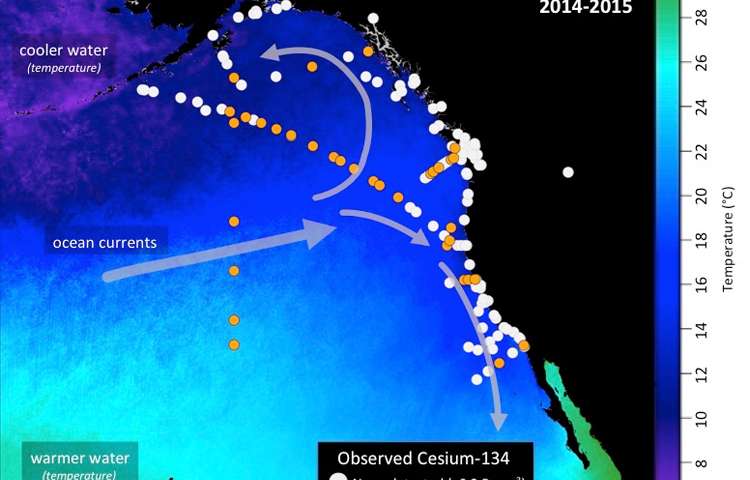WOODS HOLE, Massachusetts – A study led by Ken Buesseler, a marine radiochemist from the nonprofit Woods Hole Oceanographic Institution, revealed that there are increased levels of radioactivity off North American coasts left by the Fukushima disaster in March 2011.
Researchers tested hundreds of samples of Pacific Ocean water and found trace amounts of isotopes of cesium, an extremely reactive alkali metal, more than four years after the nuclear power plant’s meltdown. Buesseler will present his findings at the American Geophysical Union conference in San Francisco on December 14.

According to the study, cesium-134 was identified within several miles off the Oregon, Washington and California coasts, as well as offshore from Canada’s Vancouver Island. It is an isotope directly linked to the Fukushima nuclear disaster, but with a 2-year half-life, it disappears quickly.
On the other hand, cesium-137 was detected in most of the seawater samples, since it has a 30-year half-life and some of it was left over from nuclear weapons testing carried on in the 1950s to 1970s. The results show that radiation is not only spread in a few locations, but it can be observed along a stretch of more than 1,000 miles (1,600 km) offshore.
One of the samples was collected at 1,600 miles west of San Francisco. It showed cesium levels 50 percent higher than all samples that had been collected since an expedition organized by Buesseler three months after the nuclear accident.
However, those levels do not represent a threat to human or marine life, since they are 500 times lower than the safety limits established by the U.S. government. That means that swimmers, boaters and other people engaged in recreational sea activities are not at risk. Nevertheless, the findings suggest that further research is needed in order to make sure the radioactivity levels remain low.
“Despite the fact that the levels of contamination off our shores remain well below government-established safety limits for human health or to marine life, the changing values underscore the need to more closely monitor contamination levels across the Pacific,” as Buesseler pointed out in an email.
He also called attention to the fact that the radioisotopes will later serve as markers for scientists involved not only in studies of ocean currents, but also of coastal and offshore waters.
According to a release from the Woods Hole Oceanographic Institution (WHOI), Buesseler’s findings are linked to those reported by the group Kelp Watch and also by the team of Canadian researchers working under the InFORM umbrella. But whilst Buesseler focuses only on ocean chemistry, the InFORM scientists study biological organisms and have not detected Fukushima cesium in fish samples collected in British Columbia.
Buesseler continues studying the leaks from Fukushima Dai-ichi along with Japanese colleagues. By collecting samples of marine organisms, ocean water, seafloor sediment and groundwater from as close as one kilometer (one-half mile) away from the reactors, they found in October that radioactivity off the nuclear power plant is still elevated, 10 to 100 times higher than off the North American coast. Even when the rates are thousands of times lower than they were in 2011, the research confirms that the plant continues to contaminate the ocean.
Buesseler is currently calculating with colleagues at WHOI the amount of radioactive material that is still going to the ocean in a daily basis as a consequence of a colossal earthquake that triggered a tsunami that struck the Fukushima plant, 130 miles (209 km) northeast of Tokyo, causing the world’s worst nuclear disaster since Chernobyl in 1986.
The tremendous accident produced a triple nuclear meltdown and marked the second disaster to be considered as a Level 7 event, according to the classification of the International Nuclear Event Scale. No fatalities due to short term overexposure to radiation have been reported, but an estimated of 18,500 people died as a result of the earthquake and tsunami.
Source: Woods Hole Oceanographic Institution

Buesseler is currently calculating with colleagues at WHOI the amount of radioactive material that is still going to the ocean in a daily basis
High levels of Fukushima radioactivity …
Researchers tested hundreds of samples of Pacific Ocean water and found trace amounts of isotopes of cesium
…
those levels do not represent a threat to human or marine life, since they are 500 times lower than the safety limits established by the U.S. government.
…
swimmers, boaters and other people engaged in recreational sea activities are not at risk
…
No fatalities due to short term overexposure to radiation have been reported
because I trust everything I read on the internet.
Those are all quotes from this article.
Contrasting the ridiculous, over the top headline, with the, substantially more sane, article contents themselves.
Title: ZOMG! Radiation!
Article: Safe levels of radiation detected.